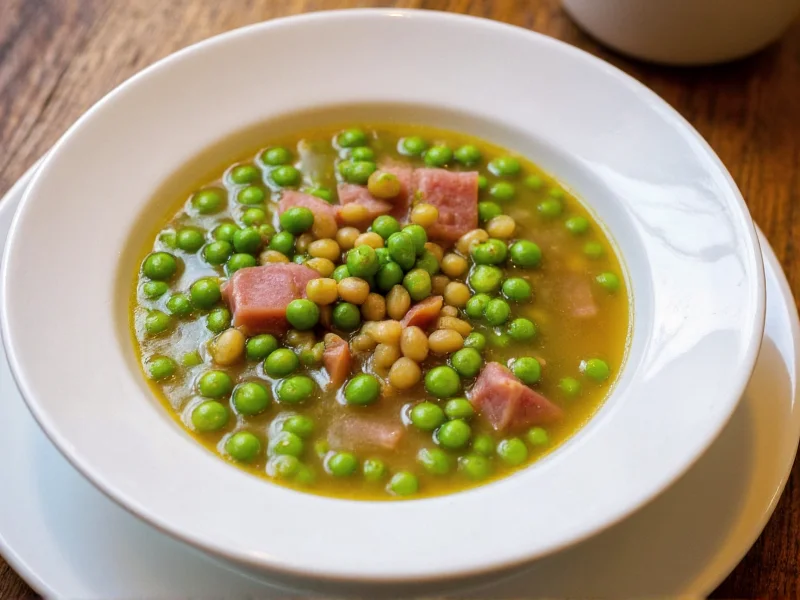Pea and ham soup represents one of history's most enduring comfort foods, with roots tracing back to 17th century England and continental Europe. This humble dish sustained families through harsh winters and lean times, transforming simple pantry staples into a deeply flavorful, nutrient-dense meal. Understanding the authentic preparation method separates truly traditional versions from modern shortcuts that compromise texture and depth of flavor.
The Historical Journey of Pea and Ham Soup
Originally known as "pease pottage" or "pease porridge," this dish dates to medieval times when dried peas provided essential protein during meatless religious observances. European peasants simmered split peas with whatever smoked meats were available, creating a practical one-pot meal that cooked slowly over hearth fires. The soup gained prominence during the 18th and 19th centuries as European immigrants brought their culinary traditions to North America, where ham became the preferred smoked meat addition.
Essential Ingredients for Authentic Flavor
Creating genuine traditional pea and ham soup requires specific ingredients that work together to develop complex flavors:
| Ingredient | Traditional Purpose | Authentic Selection Tips |
|---|---|---|
| Green split peas | Natural thickening and protein base | Use whole, unprocessed dried peas without added preservatives |
| Smoked ham hock | Provides deep smokiness and gelatinous texture | Select meaty hocks with visible marbling, not pre-cooked varieties |
| Onion, carrot, celery | Aromatic foundation (mirepoix) | Fresh vegetables, not frozen or powdered substitutes |
| Bay leaves | Earthy herbal note | Use whole dried leaves, not ground |
Step-by-Step Traditional Preparation Method
Authentic traditional pea and ham soup requires patience and proper technique to achieve the characteristic thick, velvety texture without additives:
- Prepare the ham hock: Rinse thoroughly and soak in cold water for 30 minutes to remove excess salt
- Build flavor foundation: Place ham hock in large pot with 8 cups cold water, bring to gentle simmer
- Add vegetables: After 20 minutes, add chopped onion, carrot, celery, and bay leaves
- Incorporate peas: Stir in 2 cups rinsed split peas, ensuring they're fully submerged
- Simmer patiently: Maintain gentle simmer (not boil) for 2-3 hours until peas completely break down
- Remove ham hock: After cooking, remove hock, shred meat, and return to soup
- Season carefully: Adjust salt only at the end, as ham contributes significant sodium
Avoiding Common Preparation Mistakes
Many home cooks encounter issues when preparing traditional pea and ham soup. Understanding these pitfalls ensures authentic results:
- Boiling instead of simmering: Vigorous boiling creates foamy, uneven texture rather than smooth consistency
- Adding salt too early: Salt added at beginning can prevent peas from softening properly
- Using split pea soup mix: Commercial mixes often contain thickeners and preservatives absent in traditional recipes
- Insufficient cooking time: Authentic texture requires full breakdown of peas through extended simmering
- Using ham steak instead of hock: Ham hock provides essential collagen for proper mouthfeel
Storage and Reheating for Optimal Flavor
Traditional pea and ham soup actually improves with time as flavors meld. Proper storage maintains quality:
- Cool completely before refrigerating in airtight containers
- Refrigerate for up to 5 days or freeze for 3 months
- Reheat gently over medium-low heat, adding water or broth if too thick
- Stir frequently during reheating to prevent sticking
- Enhance reheated soup with fresh herbs like parsley or thyme
Variations Across Culinary Traditions
While maintaining core elements, regional adaptations of traditional pea and ham soup showcase cultural influences:
- British version: Often includes pearl barley and a splash of Worcestershire sauce
- French potage Saint-Germain: Features fresh peas in season with added lettuce
- American Midwest style: Sometimes incorporates potatoes and smoked bacon
- Canadian adaptation: May use maple-cured ham and add a touch of vinegar
Nutritional Profile of Authentic Pea and Ham Soup
Traditional preparation yields significant nutritional benefits without modern modifications:
- High in plant-based protein (18g per serving) from split peas
- Excellent source of dietary fiber (15g per serving) supporting digestive health
- Naturally low in fat when excess fat from ham hock is removed
- Rich in potassium, iron, and B vitamins from whole food ingredients
- No added thickeners or artificial ingredients in authentic preparation
Perfecting Your Traditional Pea and Ham Soup
Mastering this classic dish requires attention to detail throughout the cooking process. The most successful traditional pea and ham soup recipes balance patience with proper technique. Remember that authentic versions develop their characteristic thick texture naturally through the breakdown of split peas during extended simmering, not through added thickeners. The ham hock's collagen transforms the soup into a rich, satisfying meal that has nourished generations. For those seeking an authentic slow cooker traditional pea and ham soup experience, maintain low heat settings and avoid opening the lid frequently to preserve consistent temperature.











 浙公网安备
33010002000092号
浙公网安备
33010002000092号 浙B2-20120091-4
浙B2-20120091-4